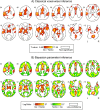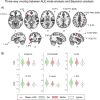Evidence for non-selective response inhibition in uncertain contexts revealed by combined meta-analysis and Bayesian analysis of fMRI data
- PMID: 35710930
- PMCID: PMC9203582
- DOI: 10.1038/s41598-022-14221-x
Evidence for non-selective response inhibition in uncertain contexts revealed by combined meta-analysis and Bayesian analysis of fMRI data
Abstract
Response inhibition is typically considered a brain mechanism selectively triggered by particular "inhibitory" stimuli or events. Based on recent research, an alternative non-selective mechanism was proposed by several authors. Presumably, the inhibitory brain activity may be triggered not only by the presentation of "inhibitory" stimuli but also by any imperative stimuli, including Go stimuli, when the context is uncertain. Earlier support for this notion was mainly based on the absence of a significant difference between neural activity evoked by equiprobable Go and NoGo stimuli. Equiprobable Go/NoGo design with a simple response time task limits potential confounds between response inhibition and accompanying cognitive processes while not preventing prepotent automaticity. However, previous neuroimaging studies used classical null hypothesis significance testing, making it impossible to accept the null hypothesis. Therefore, the current research aimed to provide evidence for the practical equivalence of neuronal activity in the Go and NoGo trials using Bayesian analysis of functional magnetic resonance imaging (fMRI) data. Thirty-four healthy participants performed a cued Go/NoGo task with an equiprobable presentation of Go and NoGo stimuli. To independently localize brain areas associated with response inhibition in similar experimental conditions, we performed a meta-analysis of fMRI studies using equal-probability Go/NoGo tasks. As a result, we observed overlap between response inhibition areas and areas that demonstrate the practical equivalence of neuronal activity located in the right dorsolateral prefrontal cortex, parietal cortex, premotor cortex, and left inferior frontal gyrus. Thus, obtained results favour the existence of non-selective response inhibition, which can act in settings of contextual uncertainty induced by the equal probability of Go and NoGo stimuli.
© 2022. The Author(s).
Conflict of interest statement
The authors declare no competing interests.
Figures






Similar articles
-
Impaired Non-Selective Response Inhibition in Obsessive-Compulsive Disorder.Int J Environ Res Public Health. 2023 Jan 9;20(2):1171. doi: 10.3390/ijerph20021171. Int J Environ Res Public Health. 2023. PMID: 36673927 Free PMC article.
-
Proactive Control Strategies for Overt and Covert Go/NoGo Tasks: An Electrical Neuroimaging Study.PLoS One. 2016 Mar 24;11(3):e0152188. doi: 10.1371/journal.pone.0152188. eCollection 2016. PLoS One. 2016. PMID: 27010832 Free PMC article.
-
The dorsal medial frontal cortex mediates automatic motor inhibition in uncertain contexts: evidence from combined fMRI and EEG studies.Hum Brain Mapp. 2014 Nov;35(11):5517-31. doi: 10.1002/hbm.22567. Epub 2014 Jun 23. Hum Brain Mapp. 2014. PMID: 24954611 Free PMC article.
-
The intersection between response inhibition and substance use among adolescents.Addict Behav. 2018 Mar;78:228-230. doi: 10.1016/j.addbeh.2017.11.043. Epub 2017 Nov 29. Addict Behav. 2018. PMID: 29223025 Free PMC article. Review.
-
Inhibitory control in trauma-exposed youth: A systematic review.Neurosci Biobehav Rev. 2020 Nov;118:451-462. doi: 10.1016/j.neubiorev.2020.06.001. Epub 2020 Jun 20. Neurosci Biobehav Rev. 2020. PMID: 32574571
Cited by
-
Impaired Non-Selective Response Inhibition in Obsessive-Compulsive Disorder.Int J Environ Res Public Health. 2023 Jan 9;20(2):1171. doi: 10.3390/ijerph20021171. Int J Environ Res Public Health. 2023. PMID: 36673927 Free PMC article.
References
Publication types
MeSH terms
LinkOut - more resources
Full Text Sources
Medical
Research Materials

